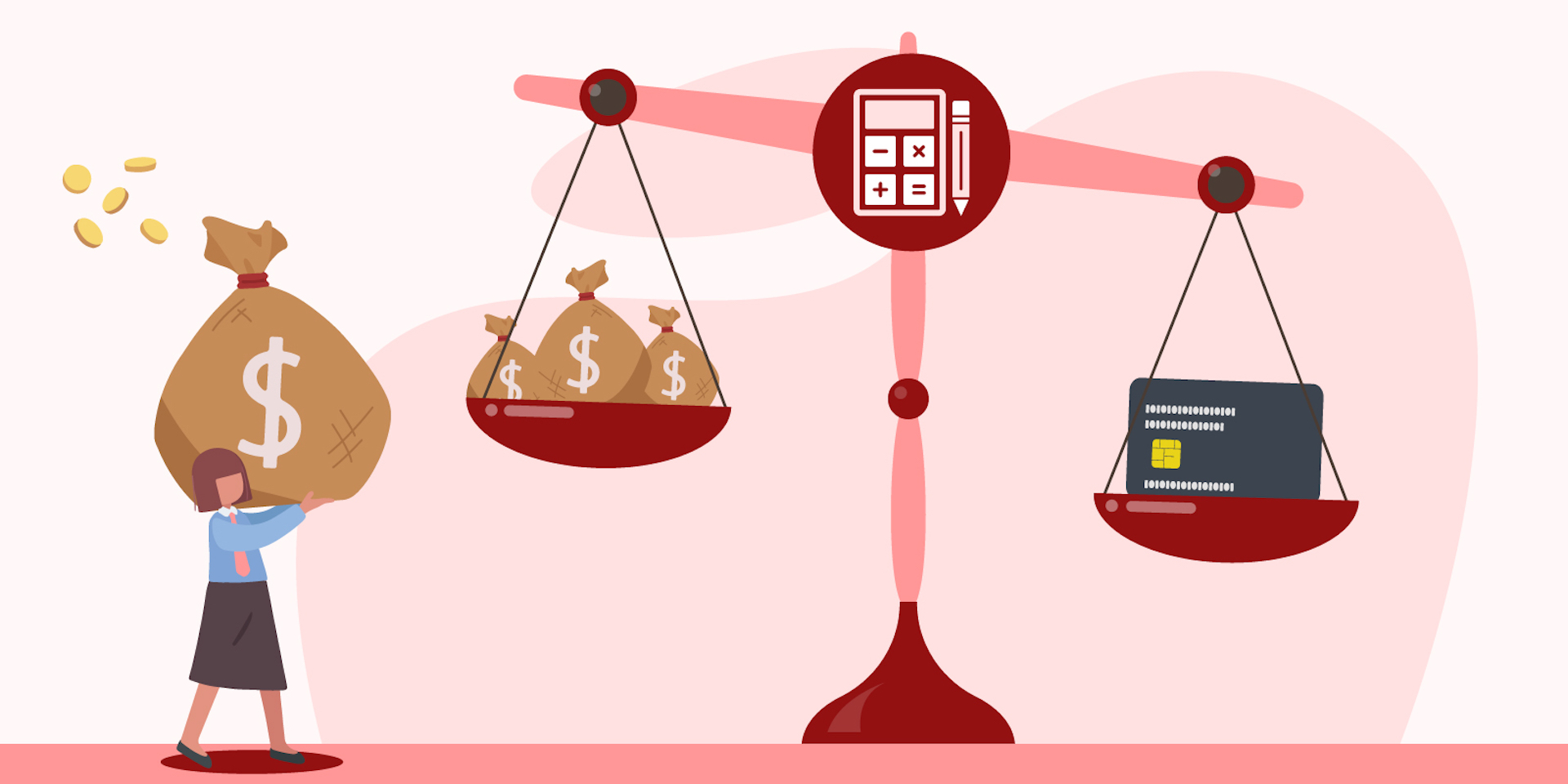If you ever want to own a home, take out a car loan or apply for a personal loan, one of the first things you need to do is understand your financial situation. Do you currently know your debt to income ratio? Do you know what goes into it? If not, keep reading, and we will help you understand where you stand financially, why it matters and what steps you can take to improve your DTI.
What is a DTI?
Debt-to-income ratio, or DTI, is a financial ratio that calculates the percentage of a person’s monthly income that goes towards paying their debts.
It is calculated by dividing a person’s total monthly debt payments by their gross monthly income. This ratio is used by lenders to determine how much a person can afford to borrow and is an important factor in deciding whether to approve a loan or credit application. It is also used by individuals to assess their own financial health and determine if they have too much debt. A high debt-to-income ratio may indicate that a person is struggling to manage their debts and may be at a higher risk of defaulting on their loans.
How to Calculate your Debt-to-Income Ratio
To calculate your debt-to-income (DTI) ratio, you need to divide the total you spend on debt payments each month by your gross monthly income. Your gross monthly income is the amount you earn before taxes and other deductions. To get your DTI calculation, follow these steps:
- Add together all your monthly debt payments, including credit card payments, student loan payments, and any other outstanding loans.
- Divide it by your gross monthly income.
- Multiply the result by 100 to convert it to a percentage.
For example, if your monthly debt payments total $500 and your gross monthly income is $2,500, your DTI would be 20%, calculated as follows:
- Add up your monthly debt payments: $500
- Divide your monthly debt by your gross monthly income: $500 / $2,500 = 0.20
- Multiply the result by 100 to convert it to a percentage: 0.20 x 100 = 20%
What is a Good Debt-to-Income Ratio?
A good debt-to-income (DTI) ratio is generally considered to be 36% or less.
This means that your total monthly debt payments, including mortgage payments, credit card payments, and any other outstanding loans, should be 36% or less of your gross monthly income.
For example, if your gross monthly income is $4,000, your monthly debt payments should be $1,440 or less to have a DTI of 36% or less.
Front-end DTI
A front-end debt-to-income (DTI) ratio is a measure of how much of your gross monthly income is used to make your housing payments (mortgage or rent). It is calculated by dividing your monthly housing expenses by your monthly gross income. For example, if your gross monthly income is $5,000 and your monthly housing expenses are $1,500, your front-end DTI ratio would be 30%.
The front-end DTI ratio is one way that lenders can evaluate your ability to afford a mortgage or other type of loan.
Lenders generally want to see a front-end DTI ratio of 28% or less, although some may be willing to consider a higher ratio depending on your credit history and other factors. A high front-end DTI ratio can make it difficult for you to qualify for a loan and can also increase your risk of defaulting on your loan. Therefore, it’s important to keep your front-end DTI ratio in mind when considering whether or not you can afford a new housing payment.
Back-end DTI
A back-end debt-to-income (DTI) ratio is a measure of how much of your gross monthly income is used to make all of your debt payments, not just your housing payments. Debt that’s used to calculate your back-end DTI includes your housing payment, car loan payment, credit card payment, and any other regular debt payments.
To calculate, divide your total monthly debt payments by your gross monthly income. For example, if your gross monthly income is $5,000 and your total monthly debt payments are $2,000, your back-end DTI ratio would be 40%.
The back-end DTI ratio is one way that lenders can evaluate your overall debt load and determine whether or not you can afford to take on additional debt. Lenders generally want to see a back-end DTI ratio of 36% or less, although some may be willing to consider a higher ratio depending on your credit history and other factors.
A high back-end DTI ratio can make it difficult for you to qualify for a loan and can also increase your risk of defaulting on your loan. Therefore, it’s important to keep your back-end DTI ratio in mind when considering whether or not you can afford to take on new debt.
Does your DTI Affect your Credit Score?
While your debt-to-income ratio is not directly included in your credit score, it can indirectly affect your credit score in several ways.
First, a high debt-to-income ratio can make it difficult for you to make your monthly debt payments on time, which can lead to late payments and missed payments. These late and missed payments can have a negative impact on your credit score. Second, a high debt-to-income ratio can indicate that you are carrying a lot of debt, which can be a red flag to lenders and potentially lead to a lower credit score.
Finally, having a high debt-to-income ratio makes it much more difficult to qualify for new credit, such as a mortgage or car loan. This can limit your ability to improve your credit score by taking on new credit and making timely payments on that credit.
Overall, while your debt-to-income ratio is not directly included in your credit score, it can have a significant impact on your ability to maintain a good credit score.
When Does a DTI Matter?

Your debt-to-income (DTI) ratio is typically reviewed by lenders when you apply for credit. Lenders use your DTI to determine how likely you are to repay your debts. A high DTI can indicate that you are overextended and may be a higher risk for the lender. A lower DTI, on the other hand, can suggest that you are in good financial health and may be more likely to repay your debts.
Why Your DTI Matters
Debt-to-income (DTI) ratio is important because it is used by lenders to determine how much a person can afford to borrow.
Lenders want to ensure that borrowers will be able to make their monthly loan payments on time and in full, and a person’s DTI ratio can provide important information about their ability to do so. A high DTI ratio can indicate that a person is carrying a large amount of debt relative to their income, which can put them at a higher risk of defaulting on a loan.
On the other hand, a low DTI ratio can indicate that a person has a good handle on their debt and is more likely to be able to make their loan payments on time.
Types of Lenders looking at DTIs
There are several types of lenders that look at your DTI ratio.
Here are a few common ones that examine your DTI:
- Mortgage lenders
- Auto lenders
- Credit card companies
- Personal loan companies
These lenders want to ensure that borrowers will be able to make their monthly loan payments on time and in full—and a person’s DTI ratio can provide important information about their ability to do so.
Some lenders may have specific DTI requirements, depending on the type of loan, that borrowers must meet in order to qualify for a loan.
For example, a lender may require that a borrower’s DTI ratio be below a certain threshold, such as 36% or 43%, in order to qualify for a mortgage. It is important to note that not all lenders will use the same DTI ratio requirements, and some may be more lenient than others.
5 Ways to Improve your DTI
Concerned about your debt-to-income ratio? Here are five ways you can improve your DTI.
1. Pay off your outstanding debts
This can help reduce your monthly debt payments and improve your DTI. For example, if you are just paying the minimum credit card payments each month, you are prolonging your current debt and will end up paying a lot more in interest in the end.
2. Increase your income
Earning more money can help you pay off your debts more quickly and improve your DTI.
3. Negotiate lower interest rates on your loans
If you have higher interest rate loans, you may be able to save money by negotiating a lower interest rate. A great way to do this is to look into mortgage or auto loan refinancing options.
4. Consolidate your debts
If you have multiple outstanding loans, consolidating them into one loan with a lower interest rate can help you save money and improve your DTI.
5. Create a budget
You’ve heard it before, but creating a budget can help you identify areas where you can cut expenses and free up more money to pay off your debts. This budget should include everything you spend in a month.
Improving your DTI can have a positive impact on your credit score and can make you more attractive to lenders. It is important to remember, however, that improving your DTI takes time—there’s no real quick fix. Instead, you’ll need to be patient and disciplined in your efforts to reduce your debt and improve your financial health.
Debt to Income Ratio vs. Debt to Limit Ratio
The debt-to-income (DTI) ratio and the debt-to-limit (DTL) ratio are two different measures of your debt. Your DTI is calculated by dividing your total monthly debt payments by your gross monthly income. It is a measure of how much debt you have relative to your income and is used by lenders to determine how likely you are to repay your debts.
On the other hand, your debt-to-limit ratio (DTL) calculation is made by dividing your total outstanding debt by your credit limit. It is a measure of how much of your available credit you are using. Your DTL is used for credit scoring models to determine your credit score.
In general, a low DTI and a low DTL are both considered to be good for your credit score. A high DTI can indicate that you are overextended, while a high DTL can suggest that you are using too much of your available credit—both may label you a higher risk for lenders. It is important to manage both your DTI and your DTL to maintain a good credit score.
DTI FAQs
Here are a few commonly asked questions when it comes to your debt-to-income ratio.
Does child support go into a DTI?
Yes, child support payments can affect your debt-to-income (DTI) ratio. If you have high child support payments, it can increase your DTI ratio and make it more difficult for you to qualify for a loan. It’s important to keep this in mind when applying for credit and to consider how your child support payments may affect your ability to borrow money.
Do property taxes affect your DTI?
Yes, property taxes and monthly housing expenses, such as mortgage payments or rent, can affect your debt-to-income ratio. Property taxes and monthly housing expenses are considered to be part of your monthly debt payments when calculating your debt-to-income ratio. Therefore, if your property taxes and monthly housing expenses are high, your debt-to-income ratio will be higher as well. On the other hand, if your property taxes and monthly housing expenses are low, your debt-to-income ratio will be lower.
What is the highest DTI you can have and get a loan?
The maximum debt-to-income ratio that you can have and still qualify for a loan will vary depending on which type of loan you are applying for and the lender you are working with. In general, lenders want to see a debt-to-income ratio of 43% or less for a mortgage loan, but some may be willing to consider a higher ratio depending on your credit history and other factors.
For other types of loans, such as auto loans or personal loans, the maximum debt-to-income ratio may be higher. It’s always a good idea to shop around and compare offers from different lenders to see which one will be the most willing to work with you based on your specific financial situation.
What is the best way to monitor your DTI?
It’s a good idea to monitor your debt-to-income ratio on a regular basis, such as once a month or once a quarter. This will help you keep track of how much of your income is going toward debt payments and allow you to make any necessary adjustments to your spending habits to maintain a healthy ratio. You can also use online calculators or financial planning tools to help you monitor your debt-to-income ratio and make sure you are on track to meet your financial goals.
Don’t Neglect Your DTI Ratio
It might be obvious, but a higher DTI can prohibit you from taking on loans for major purchases, like auto loans, home loans and the amount of credit utilization available to you. Monthly bills are a part of life. However, it’s important to keep your debt-to-income ratio in mind when considering whether or not you can afford to take on new debt, such as a car loan or a mortgage.
Once you have a grasp on your financial situation, you can start to work on ways to lower or maintain a healthy DTI.
You might also be interested in: 9 Ways To Consolidate Debt Today







